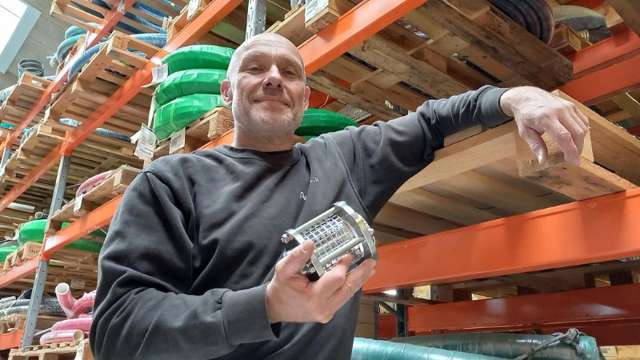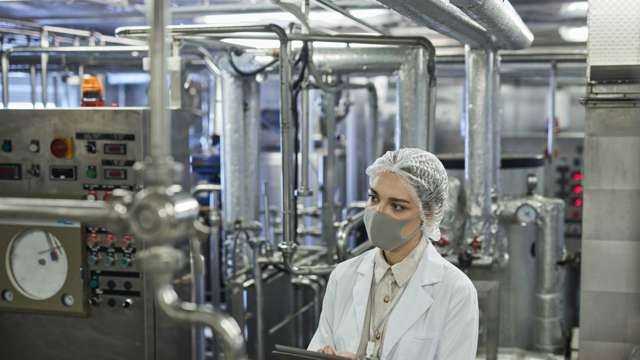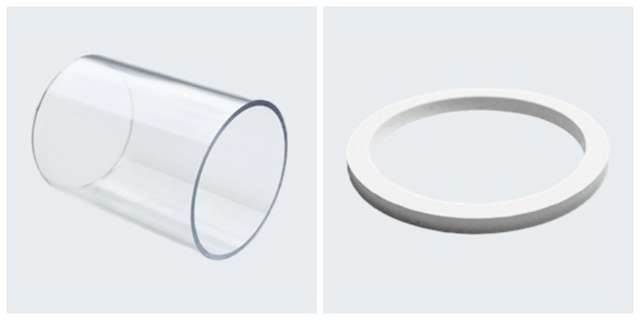
In-Line sight glass, fluoride thermoplastic with protective net

In-Line sight glass, fluoride thermoplastic without protective net

In-Line sight glass, weld on, DS/SMS/ISO

In-Line sight glass, weld on, DIN

Glass, Borosilicate for In-Line sight glass

Protective net for In-Line sight glass

Protective screen for In-Line sight glass, polycarbonate

Gasket for In-Line sight glass

Sight glass with nut, DIN, borosilicate

Sight glass for DIN union, Borosilicate

Gasket for DIN sight glass

Nut for DIN sight glass

Sight glass for ISO Clamp union, Borosilicate
Sight glasses for optimal flow inspection
In the process industry, it’s crucial to be able to monitor liquids and gases in real-time without interrupting production. Sight glasses makes this possible by giving operators a clear view into closed systems so that any deviations can be quickly detected and dealt with.
From food production to chemical manufacturing, sight glasses play a key role in safety, quality and operational optimization. They make it possible to inspect flow, color changes, particle content and levels without opening the system - a factor that both reduces maintenance needs and minimizes the risk of contamination in sterile environments.
But where are sight glasses used in the process industry and what benefits do they offer? How do you choose the right sight glass for your needs? In the following, we explain what a sight glass is, where it’s used and what benefits it offers. We'll also go through our most popular sight glass models and accessories, as well as what to look out for when choosing a sight glass.
Read along and learn more!
What is a sight glass?

In modern process plants, a sight glass is often an indispensable component that ensures technicians and service operators can monitor the flow of liquids and gases without having to interrupt or open the production system. Whether there’s a need to check liquid levels, colors, temperatures or gas flows, a sight glass allows for quick and accurate inspection of operations. This is especially important in processes where even small deviations can have major consequences for product quality or process plant safety.
Sight glasses are typically made of stainless steel combined with tempered or chemically resistant glass to protect against mechanical impact and corrosive substances. The construction makes them extremely robust and durable - even in environments with extreme conditions such as high temperatures, high pressure and aggressive media.
Where are sight glasses used in the process industry?
Sight glasses are widely used in the process industry for applications with high hygiene and reliability requirements. They allow for both monitoring and visual inspection of liquids, gases or other materials in a closed system without interrupting the production process.
Depending on the industry, sight glasses can have different functions and benefits. Overall, they not only ensure effective monitoring, but also help maintain high safety and hygiene standards in critical production environments.
Food industry
- Hygienic monitoring of liquids without risk of contamination.
- Real-time inspection of color and consistency changes for consistent quality.
- Resistant to CIP cleaning and aggressive detergents.
Pharmaceutical industry
- Complies with strict hygiene requirements and GMP (Good Manufacturing Practice)- standards.
- Withstands CIP and SIP processes for sterile operation.
- Reduces the risk of cross-contamination in closed systems.
- Available with special coatings for aggressive chemicals.
Chemical industry
- Chemical-resistant materials withstand aggressive liquids.
- Safely handles extreme temperatures and high pressures.
- Enables safe visual inspection without risk to operators.
- Stable and maintenance-free solution for demanding environments.
How to choose the right sight glass

When choosing the right sight glass, you should consider several important factors:
- Pressure and temperature
- System compatibility
- Safety
Pressure and temperature
Sight glasses can be used for both high and low temperatures depending on the process requirements. However, it’s most common for sight glasses to withstand high temperatures as they’re often used in systems with hot processes, steam, heated liquids or chemical reactions - for example pasteurization or sterilization. Depending on the model, our range covers from -40°C up to +280°C.
System compatibility
Sight glasses are available with different connections, including BSP, Clamp or welded connections. The selection means that in most cases you can find a model that will fit the process plant. You must make sure that the sight glass fits the existing pipe dimensions to ensure correct installation and optimal function. Additionally, it's important to consider material selection and design to withstand the conditions and pressure the system requires.
Safety
In certain production environments, the use of sight glasses is out of the question as they’d pose a safety risk to either employees or the end consumer. Sight glasses are available shatterproof, but even the most robust can shatter if used incorrectly.
How to extend the life of your sight glass
Regular maintenance of the sight glass is essential to maintain reliability and extend its lifetime. Often, it’s exposed to high temperatures, pressure variations and aggressive chemicals, which requires continuous monitoring and proper care.
- Gasket inspection - Replace sealing rings regularly to avoid leaks.
- Prevent thermal shock - Avoid sudden temperature changes that can damage the glass.
- Cleaning - Use approved products and avoid abrasives that can scratch.
- Inspection - Check for cracks, cloudiness and worn seals to prevent downtime.
- Safety - Use protective screens in high-pressure areas and mount correctly.
Our most popular sight glasses & accessories

Glass & gaskets for In-Line sight glass
Our borosilicate glass for In-Line sight glass is highly resistant to temperature, chemicals and mechanical stress. In other words, you get long life and reliability if you need to replace your In-Line glass.
Highlights: Borosilicate glass for In-Line sight glass
- Can handle up to 280°C operating temperature.
- Stable in chemical processes, including CIP cleaning.
- Ideal for food and pharmaceutical production in particular.
But maybe you also need matching gaskets? Then our EPDM rubber gasket for In-Line sight glass is the way forward.
Highlights: Gasket for In-Line sight glass
- Covers wide temperature range (-40°C to +150°C).
- Chemically resistant due to the EPDM rubber material.
- Ideal for use across industries for applications requiring reliable sealing and chemical resistance.
Stainless steel & DIN-compliant In-Line sight glass with weld ends

We've long had our stainless steel In-Line sight glass for DS/SMS/ISO standards in stock, but now the same model is also available for DIN. If you use this type of coupling in your process plant, this product may be relevant to you.
Highlights: DIN-compliant In-Line sight glass with weld ends
- Resistant up to +120°C temperature.
- Withstands pressures up to 10 bar (DN 10-65), 8 bar (DN 80) and 7 bar (DN 100).
- Design prevents misalignment of the sight glass with predefined sealing ring and optional EPDM or nitrile gasket.
- Safety net in polycarbonate (stainless steel must be purchased separately).
- Ideal for food and pharmaceutical applications.
DIN-compliant stainless-steel sight glass with nut

Sight glasses with unions are very popular due to their unique construction that allows the glass to be mounted directly on the pipe system, for example at a T-piece.
Our DIN-compliant stainless-steel sight glass with nut is constructed with borosilicate glass and is highly resistant to even the harshest production conditions. Precisely because of the glass material, the sight glass remains reliable and durable over time.
And when considering possible temperature changes in the production process, this type can withstand a change from +230°C to +20°C in just one minute under a working pressure of 6 bars! This makes the application possibilities almost endless.
Frequently asked questions

What are the benefits of stainless-steel sight glass?
Stainless steel provides high corrosion resistance, long lifetime and a hygienic surface, making it suitable for food and pharmaceutical applications.
What are the benefits of borosilicate glass?
Borosilicate glass is chemically resistant, withstands temperatures up to +280°C and has high resistance to thermal shock. It ensures long lifetime, clear transparency and reliable performance in demanding industrial environments.
Can sight glass withstand high pressures and temperatures?
Yes, depending on glass type and construction. Borosilicate and sapphire glass can withstand temperatures up to +280°C and high pressures, while standard tempered glass often has lower resistance.
How do you maintain a sight glass correctly?
Regular inspection of sealing rings and the glass surface for damage is essential. Maintenance depends on the environment - in the food industry CIP cleaning is recommended, while chemically aggressive processes require frequent gasket replacement.
Are there special sight glasses for sterile processes?
Yes, CIP/SIP compliant sight glasses are designed for sterile production environments.
 da
da
 de
de
 en
en
 sv
sv